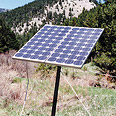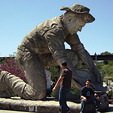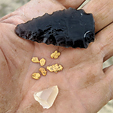All Articles
Legislative and Regulatory Update
January 2006 by Staff
• Karuk Tribe at it again
The Karuk Tribe, recently thwarted in their attempt to shut down mining on several rivers in northern California, have found a new ally—the California Department of Fish & Game.
Unbeknownst to miners, the Karuk’s filed a lawsuit against Fish & Game earlier this year in Alameda County Superior Court after losing in a lawsuit against the Forest Service. Fish & Game and the Karuk Tribe were reportedly close to signing an agreement that would have placed significant restrictions on all mining in riparian areas of the Klamath National Forest when miners discovered the proposed changes in early December.
Members of The New 49’ers, a mining and prospecting club located in Northern California, are spearheading the effort to intervene in the case. Many of the group’s mining claims are located on the Salmon, Klamath, and Scott rivers—all areas that would be affected by an agreement between the Karuk’s and Fish & Game.
The New 49’ers have retained attorney James Buchal to intervene on the behalf of miners. Buchal is the same attorney who intervened on behalf of miners when the Karuk’s sued the Forest Service in a similar attempt to restrict mining on the same rivers. (See “Miners Win in Karuk Tribe v. USFS” in our August 2005 issue.)
A fundraising drive is currently underway to pay for attorney costs related to this latest case. See page 46 for further information.
• Republicans drop mining provision from budget bill
The recently introduced legislation to reinstate the patenting of mining claims and reset claim fees, among other things, has been withdrawn.
Representative Jim Gibbins stated that procedural rules in the Senate would have prevented the changes from taking effect as part of the budget reconciliation bill, though he is “committed to modernizing the mining law to meeting our 21st -century needs.”
Known as the Pombo bill, the changes to the Mining Law were attached to the budget reconciliation bill. Hopefully the changes will be introduced again in a separate bill.
• Idaho miners agree to stricter bonding requirements
Idaho’s Board of Land Commissioners and Environmental Quality Board approved new rules that will increase the cost of doing business for some miners in Idaho.
The rules apply to mines that use cyanide, increasing the bond from $100,000 to the actual estimated cost to close the mine. The rules were put together by representatives of the mining industry, environmentalists and state regulators.
The rules were promulgated after Atlanta Gold Corp. applied to the US Forest Service and other agencies to build two open pits about 70 miles northeast of Boise near the town of Atlanta, where the company plans to mine more than 500,000 ounces of gold. Atlanta Gold plans to use cyanide leaching to recover the gold.
The area where the mine is planned eventually drains into the Boise River, which serves a population of 500,000 who depend on the river for part of their water supply, recreation and irrigation of crops.
“It’s tough but we’re not complaining,” Jack Lyman, lobbyist for the Idaho Mining Association, told The Idaho Statesman. “I’ve always argued that, ‘Tell me what the rules are and we’ll meet them.’ What we don’t want to do is to encourage a company to come to Idaho and invest, then change the rules.”
The new rules shift the responsibility for bonding of cyanide operations from the Department of Environmental Quality to the Idaho Department of Lands, which already handles reclamation bonding. The new rules will go to the Idaho Legislature, which convenes in January, for final approval.
The rules are stricter than the mining industry expected, but will likely reduce political pressure for a ban on mines using the cyanide leaching process. Similar bans were twice approved by Montana voters.
• Comments needed for Oregon turbidity review
The Oregon Department of Environmental Quality has extended the comment period on proposed revisions to turbidity regulations to February 6, 2006.
All miners who operate in or near a waterway in Oregon should review the proposed changes and provide constructive comments. Copies of the public notice, proposed changes and supporting documents can be obtained by contacting Tom Rosetta at (503) 229-5053.
Links to these documents can also be found on our website under the “Pending Rules, Regulations, Projects” section.![]()
The Ball Mill
• Bringing down the house
• German "manhandlers"
• Don't call us; we'll call you...
• Laziness pays off
Solar-Powered Placer Sampling Equipment
 One hundred and seven years ago the world’s first electric-powered bucket line dredge started to work in Montana. This summer, Montana likely saw its first solar-powered Denver Gold Saver put to work.
One hundred and seven years ago the world’s first electric-powered bucket line dredge started to work in Montana. This summer, Montana likely saw its first solar-powered Denver Gold Saver put to work.
Auburn, California
 Many of the gold camps were violent places, but in this regard, the town of Auburn exhibited a different behavior. There were few of the duels or lynchings that characterized many of the other early settlements.
Many of the gold camps were violent places, but in this regard, the town of Auburn exhibited a different behavior. There were few of the duels or lynchings that characterized many of the other early settlements.
Detecting Wet Ground Yields More Fun Than Gold
 We all continued over to another location at the top of a massive placer operation. Arriving at the draw, I showed everyone where gold had been found before and we all began detecting.
We all continued over to another location at the top of a massive placer operation. Arriving at the draw, I showed everyone where gold had been found before and we all began detecting.
The Bawl Mill
• What's that smell?
• Third time is not a charm...
• As old as the hills...really
• "Governor Sure"
• $500,000 + a trip to Greece + one renovation = how many teaching jobs?
What Are Those Rocks In My Pan?
The placer mineral identification key is designed to answer this question. It attempts to recognize all the minerals in your gold pan concentrates.
Subscription Required:
The Bawl Mill
• Rent, Lease, or Own Your Equipment
• Basic Geology for the Independent Miner—Part I Recognizing and Understanding Minerals
• A Profitable Approach—Financing Mineral Exploration With Oil & Gas Projects
• The Grubstake Gulch Placers, Alaska
• The Lynx Creek Placers, Arizona
• Gemstones in Wyoming—Part II
• The Mexican Gold Belt
• Melman on Gold & Silver
• Looking Back
• Mining Stock Quotes and Mineral & Metal Prices
Free:








